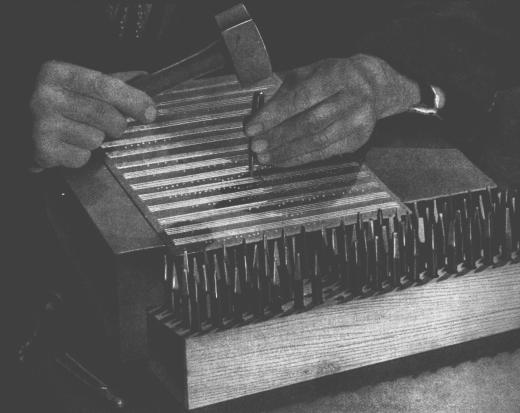| [ << Music engraving ] | [Top][Contents][Index] | [ Literature list >> ] |
| [ < The LilyPond story ] | [ Up : Music engraving ] | [ Music fonts > ] |
1.2 Engraving details
The art of music typography is called (plate) engraving, a term that derives from the manual process of music printing1. Just a few decades ago, sheet music was made by cutting and stamping the music into a zinc or pewter plate in mirror image. The plate would be inked, and the depressions caused by the cutting and stamping would hold ink. An image was formed by pressing paper to the plate. The stamping and cutting was done completely by hand and making a correction was cumbersome, so the engraving had to be nearly perfect in one go. Engraving was a highly specialized skill; a craftsman had to complete around five years of training before earning the title of master engraver, and another five years of experience were necessary to become truly skilled.
LilyPond is inspired by traditional manual engravings published by European music publishers in and towards the end of the first half of the twentieth century, including Bärenreiter, Duhem, Durand, Hofmeister, Peters, and Schott. This is sometimes regarded as the peak of traditional musical engraving practice. As we have studied these editions we have learned a great deal about what goes into a well-engraved score, and the aspects that we wanted to imitate in LilyPond.
Footnotes
(1)
Early European printers explored several processes, including hand-carved wooden blocks, movable type, and engraved sheets of thin metal. Typesetting had the advantage of being more easily corrected and facilitating the inclusion of text and lyrics, but only engraving offered the ability to do unimpeded layout and unanticipated notation. In the end, hand-engraved scores became the standard for all printed music, with the exception of some hymnals and songbooks where typesetting was justified by its ease and economy, even into the twentieth century.
| [ << Music engraving ] | [Top][Contents][Index] | [ Literature list >> ] |
| [ < The LilyPond story ] | [ Up : Music engraving ] | [ Music fonts > ] |
